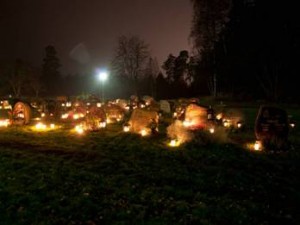關於世界許多國家的萬聖節傳統,我們特別翻譯外國網站的原文供大家參考。
資料出處 : http://www.novareinna.com/festive/world.html
圖片來源: http://allday.com/post/1058-how-halloween-is-celebrated-around-the-world/
As one of the world’s oldest holidays, Halloween is still celebrated today in several countries around the globe, but it is in North America and Canada that it maintains its highest level of popularity. Every year, 65% of Americans decorate their homes and offices for Halloween…a percentage exceeded only by Christmas. Halloween is the holiday when the most candy is sold and is second only to Christmas in terms of total sales
身為世界最古老節日之一的萬聖節,至今仍為世界許多國家所慶祝,但在北美和加拿大,還是最受歡迎。每年有65%的美國人會為萬聖節的到來特地裝飾家裡和辦公室,這是除了在聖誕節才有的盛況。萬聖節是除了聖誕節之外,糖果銷量最多的節日。
Austria
In Austria, some people will leave bread, water and a lighted lamp on the table before retiring on Halloween night. The reason for this is because it was once believed such items would welcome the dead souls back to earth on a night which for the Austrians was considered to be brimming with strong cosmic energies.
奧地利
在奧地利,有些人在萬聖節當晚休息前,會把麵包、水以及點亮的燈泡留在桌上。原因是據說這些東西會迎接亡魂重回世間,而奧地利人認為這會招致無限的能量。
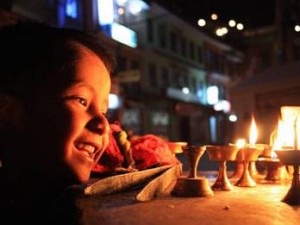
Belgium
The Belgians believe that it is unlucky for a black cat to cross once’s path and also unlucky if it should enter a home or travel on a ship. The custom in Belgium on Halloween night is to light candles in memory of dead relatives.
比利時
比利時人相信一隻黑貓穿過小巷是不吉利的,而且假如牠跑進家中或者在船上行進會招致惡運。比利時在萬聖節的習俗是會把蠟燭點亮以紀念去世的親人。
Canada
Modern Halloween celebrations in Canada began with the arrival of Scottish and Irish immigrants in the 1800s. Jack O’Lanterns are carved and the festivities include parties, trick-or-treating and the decorating of homes with pumpkins and corn stalks.
加拿大
加拿大開始過近代的萬聖節是從蘇格蘭人以及愛爾蘭人在1,800年代移入開始。在慶典和派對時會雕刻傑克南瓜燈、玩不給糖就搗蛋並且用南瓜和玉蜀黍幹裝飾住家。
Czechoslovakia
In Czechoslovakia, chairs are placed by the fireside on Halloween night. There is one chair for each living family member and one for each family member’s spirit.
捷克斯洛伐克
在捷克斯洛伐克,在萬聖節當晚會把椅子擺在爐火旁。每一張椅子代表在世的家族成員以及其靈魂。

England
At one time, English children made “punkies" out of large beetroots, upon which they carved a design of their choice. Then, they would carry their “punkies" through the streets while singing the “Punkie Night Song" as they knocked on doors and asked for money. In some rural areas, turnip lanterns were placed on gateposts to protect homes from the spirits who roamed on Halloween night. Another custom was to toss objects such as stones, vegetables and nuts into a bonfire to frighten away the spirits. These symbolic sacrifices were also employed as fortune-telling tools. If a pebble thrown into the flames at night was no longer visible in the morning, then it was believed that the person who tossed the pebble would not survive another year. If nuts tossed into the blaze by young lovers then exploded, it signified a quarrelsome marriage. For the most part however, the English ceased celebrating Halloween with the spread of Martin Luther’s Protestant Reformation. Since followers of the new religion did not believe in Saints, they saw no reason to celebrate the Eve of All Saints’ Day. However, in recent years, the American “trick or treating" custom, together with the donning of costumes for going door-to-door, has become a relatively popular pasttime among English children at Halloween, although many of the adults (particularly the older generations) have little idea as to why they are being asked for sweets and are usually ill-prepared to accommodate their small and hopeful callers.
英格蘭
曾經英格蘭小孩會把甜菜當成"南瓜”,在上面刻成他們想要的樣子。然後他們會帶著他們的”南瓜”沿街唱著南瓜歌敲門討錢。在一些鄉村地區,蕪菁燈籠會被放在門柱來保護居家於萬聖節晚上免受惡靈的打擾。另一個習俗是將物品,像石頭、蔬菜或者核果丟進火堆來驅逐惡靈。這些象徵性的獻祭也被作為算命的工具。假如丟進火堆的小石頭於隔天早上不見了,那個丟石頭的人很可能活不過隔年。假如核果是被年輕的情侶丟進火焰炸開了,代表著會有紛爭的婚姻。然而,英格蘭在馬丁路德大肆宗教改革時,中止了很多慶祝萬聖節的儀式。因為新宗教的教徒並不相信聖人,他們沒有理由慶祝萬聖節。但是在近幾年,美國人挨家挨戶”不給糖就搗蛋”的風俗和變裝一起,成為英格蘭小孩在萬聖節消遣的相關活動,即使很多大人(特別是老一輩的)不是很清楚他們被討糖的原因,他們還是為來敲門興致勃勃的孩子們作足準備。
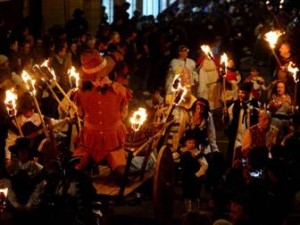
France
Unlike most nations of the world, Halloween is not celebrated by the French in order to honor the dead and departed ancestors. It is regarded as an “American" holiday in France and was virtually unknown in the country until around 1996.
法國
不像世界上大多數的國家,萬聖節在法國不是用來紀念死者和逝去的先人們。法國人把萬聖節視為是美國的節日,大概在1996年以前都還不知道有這個節日。
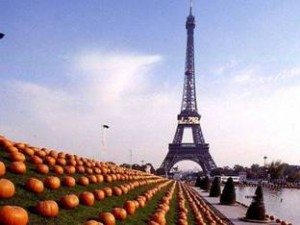
Germany
In Germany, the people put away their knives on Halloween night. The reason for this is because they do not want to risk harm befalling the returning spirits.
德國
在德國,人們再萬聖節晚上會把刀子收起來。因為他們不想冒著被回歸惡靈傷害的危險。
Ireland
In Ireland, believed to be the birthplace of Halloween, the tradition is still celebrated as much as it is in the United States. In rural areas, bonfires are lit as they were in the days of the Celts and children dress up in costumes to spend the evening “trick-or-treating" in their neighborhoods. After the visiting, most people attend parties with neighbors and friends. At these parties, many games are played, including “snap-apple," in which an apple on a string is tied to a doorframe or tree, and players attempt to take a bite out of the suspended apple. In addition to bobbing for apples, parents often arrange treasure hunts with sweets or pastries as the “treasure." The Irish also play a card game where cards are laid face-down on a table with sweets or coins beneath them. When a child selects a card, he or she receives whatever prize might be found there. A traditional food is eaten on Halloween called “barnbrack." This is a type of fruitcake which can be baked at home or store-bought. A muslin-wrapped treat is baked inside the cake which, so it is said, can foretell the future of the one who finds it. If the prize is a ring, then that person will soon be wed and a piece of straw means a prosperous year is forthcoming. Children are also known to play tricks upon their neighbors on Halloween night. One of which is known as “knock-a-dolly," where children knock on the doors of their neighbors but then run away before the door is opened.
愛爾蘭
在愛爾蘭,相傳是萬聖節的起始地,慶祝的傳統方式和美國差不多。在鄉村地區,從薩爾特時期就有點大篝火的習俗,而孩童們會變裝在鄰近地區以”不給糖就搗蛋”的方式度過傍晚。之後,大多數人會參加鄰居或者朋友家的派對,而派對中常見的遊戲是”咬蘋果”,就是用一條線把瓶果掛在門邊或者樹上,參加的人就試著隔空咬蘋果。除此之外,父母通常會安排找糖果或糕點的”尋寶”遊戲。愛爾蘭人也會玩紙牌遊戲,把紙牌面朝下放在桌上,每張壓著糖果或者硬幣,當小孩選中一張卡時,就可以獲得該張卡壓著的物品。萬聖節會吃的傳統食物是萬聖節蛋糕,是一種烘焙的水果蛋糕,可以在家自己做也可從店裡購買。蛋糕裡面會有細紗布包裹的東西,相傳吃到的人可以預知命運。假如包著的是戒指,那個人很快就會結婚,而如果是一根稻草,是指接下來會有豐收的ㄧ年。孩子們也會在萬聖夜當天到鄰居家敲門玩耍。其中一種玩法是”敲門快閃”,是指孩子敲了鄰居門之後,在鄰居開門前立刻跑走。
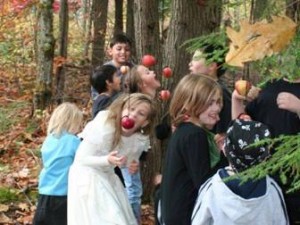
Mexico, Latin America And Spain
Among Spanish-speaking nations, Halloween is known as “El Dia de los Muertos." It is a joyous and happy holiday…a time to remember friends and family who have died. Officially commemorated on November 2 (All Souls’ Day), the three-day celebration actually begins on the evening of October 31. Designed to honor the dead who are believed to return to their homes on Halloween, many families construct an altar in their home and decorate it with candy, flowers, photographs, fresh water and samples of the deceased’s favorite foods and drinks. Frequently, a basin and towel are left out in order that the spirit can wash prior to indulging in the feast. Candles and incense are burned to help the departed find his or her way home. Relatives also tidy the gravesites of deceased family members, including snipping weeds, making repairs and painting. The grave is then adorned with flowers, wreaths or paper streamers. Often, a live person is placed inside a coffine which is then paraded through the streets while vendors toss fruit, flowers and candies into the casket. On November 2, relatives gather at the gravesite to picnic and reminisce. Some of these gatherings may even include tequila and a mariachi band although American Halloween customs are gradually taking over this celebration. In Mexico during the Autumn, countless numbers of Monarch butterflies return to the shelter of Mexico’s oyamel fir trees. It was the belief of the Aztecs that these butterflies bore the spirits of dead ancestors.
墨西哥、拉丁美國和西班牙
在西班牙語系的國家,萬聖節被稱作"El Dia de los Muertos." 是一個喜悅歡樂的節日,ㄧ個懷念逝去的親人和朋友的時候。正式慶祝的日期是11月2日(萬靈節),是一個在10月31日傍晚開始連續三天的節日,作為紀念相信當天會回家的先人,很多家庭會設祭壇並且用糖果、花、照片、鮮花以及先人喜愛的食物和水果樣品來裝飾。通常會將臉盆和毛巾放在門外以便亡靈在享用宴席時可漱洗。蠟燭和香會被點燃以便先人找到回家的路。親人們會把家中逝者的墓地打擾乾淨,包括除草、修繕和上漆。然後墓地會放置鮮花、花圈或者相思帶裝飾。常常,ㄧ個活人會躺在棺材裡被抬著遊街,然後攤販會將水果、花以蠟燭丟進棺材裡。在11月2號,家人會齊聚在墓地野餐並悼念。這些聚餐甚至會有龍舌蘭酒或者街頭樂隊,即使美式萬聖節習俗慢慢取代這個儀式。在墨西哥秋天,數不清的帝王蝴蝶會回墨西哥的冷杉林避冬。阿茲提克人相信這些蝴蝶負載著死去先人的靈魂。
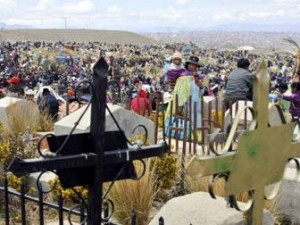
Sweden
In Sweden, Halloween is known as “Alla Helgons Dag" and is celebrated from October 31 until November 6. As with many other holidays, “Alla Helgons Dag" has an eve which is either celebrated or becomes a shortened working day. The Friday prior to All Saint’s Day is a short day for universities while school-age children are given a day of vacation.
瑞典
在瑞典,萬聖節稱為”Alla Helgons Dag”,並且是從10月31號ㄧ直到11月6號的慶典。和很多其他節日ㄧ樣,”Alla Helgons Dag”的節日不是從晚上開始慶祝,就是當天提早下班。萬聖節之前的星期五大學生都會提早下課,而學生們則是會給ㄧ天假。
